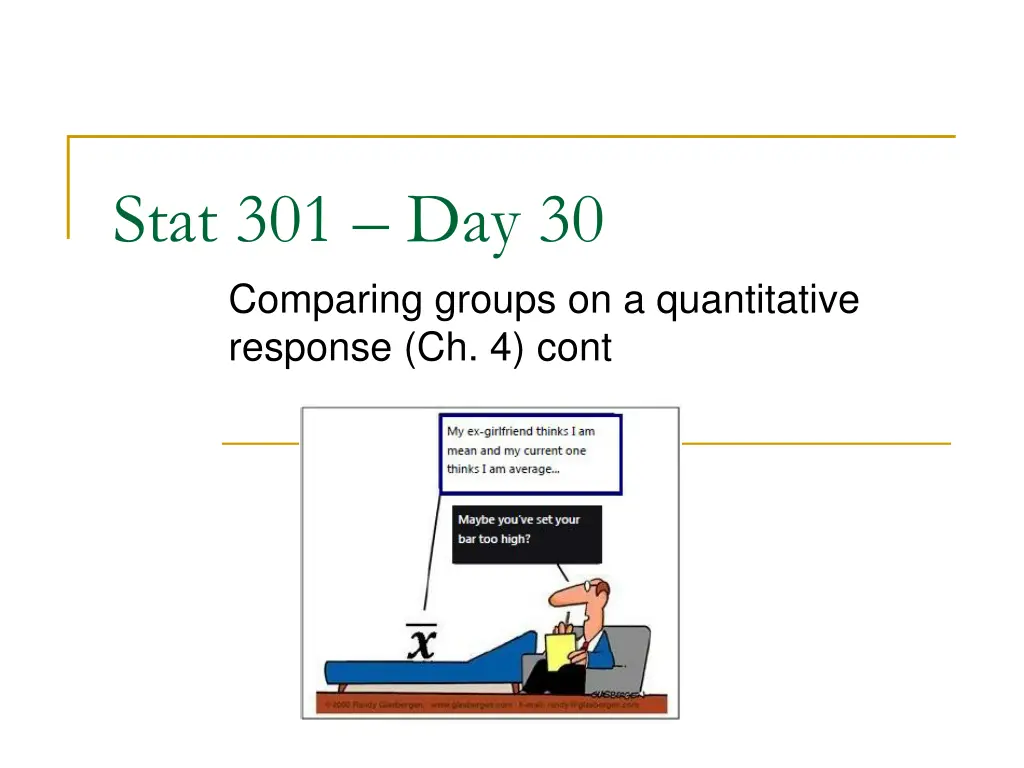
Comparing Groups on Quantitative Response
Explore the process of comparing groups on a quantitative response, focusing on topics such as two-sample t-tests, validity conditions, and technology options. Practice questions, announcements, and key concepts related to statistical analysis are covered in this informative content.
Uploaded on | 2 Views
Download Presentation

Please find below an Image/Link to download the presentation.
The content on the website is provided AS IS for your information and personal use only. It may not be sold, licensed, or shared on other websites without obtaining consent from the author. If you encounter any issues during the download, it is possible that the publisher has removed the file from their server.
You are allowed to download the files provided on this website for personal or commercial use, subject to the condition that they are used lawfully. All files are the property of their respective owners.
The content on the website is provided AS IS for your information and personal use only. It may not be sold, licensed, or shared on other websites without obtaining consent from the author.
E N D
Presentation Transcript
Stat 301 Day 30 Comparing groups on a quantitative response (Ch. 4) cont
Announcements Today: Finish 4.2, Practice questions I did update PQ 4.2A last night (not the one from text) PQ 4.2B = PP 4.2B from the text No office hour today? Optional Quiz on Monday Inv 4.2 material, two-sample t-test HW 7 posted Prep work for Tuesday: Inv 4.3 (a)-(e)
Last Time Technology detour: Graphical and Numerical summaries for comparing two (or more) groups on a quantitative response Stacked vs. Unstacked data
Last Time: Central Limit Theorem Tells us about the sampling distribution of ?1 ?2, but what we really care about is the distribution of ? = ?1 ?1+?2 ?1 ?2 ?0 2 2 ?2
Last Time When we use the sample standard deviations to calculate the standard error, the standardized statistic will often be well-modelled by a t- distribution The appropriate degrees of freedom are a little complicated, but we ll let the computer deal with that
Two-sample t procedures Validity conditions for t procedures Large populations Normal populations or Large sample sizes (~both at least 20, preferable if similar shape) Two-sample t-test (?1 ?2= ?0) ? = ?1 ?1+?2 ?2 Two-sample t-interval ?1 ?2 ?0 compare to a t distribution 2 2 2 2 ?1 ?1+?2 ?1 ?2 ? ?2
Technology Options Theory-based Inference applet Summary data Raw data (stacked vs. unstacked) R iscamtwosamplet (summary data) t.test(y ~ x, alt = , var.equal = FALSE) (raw data)
Elephants The difference in means (-.10) is .13 standard errors from 0 About 90% of random samples have a difference in means at least as large as -.10 (in either direction) when the null is true
Bootstrapping NBA Salaries: We generated many random samples from finite populations and looked at the distribution of the t-statistic. If we don t have populations, we can take random samples with replacement from the sample(s) we do have Pool together first (H0 true) Each sample individually (confidence interval)
To Do Submit Practice problems 4.2A and 4.2B (tonight?) See Week 8 wrap-up Optional (make-up) Quiz on Investigation 4.2 due Monday night Prep-work for Tuesday: Inv 4.3 (a)-(e) Start HW 7
